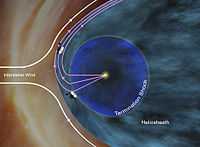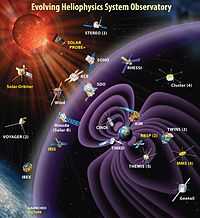Stars/Sun/Heliophysics
< Stars < Sun
"Heliophysics is a fast-developing scientific discipline that integrates studies of the Sun's variability, the surrounding heliosphere, and the environment and climate of the planets."[1]
Astronomy
Helios is a name recently given to the Sun, but in ancient history it may have referred to Saturn.
With the exception of viewing solar eclipses, the only visible portion of the sun apparently is only the outer surface of the photosphere.
Literally, heliophysics is the astrophysics of the solar ball limited by the upper surface of the photosphere.
Radiation
All of the radiation originating from, at or above the photosphere creates at least the heliosphere ending at the heliopause.
Heliophysics
"Heliophysics is concerned with laws that give rise to structures and processes that occur in magnetized plasmas and in neutral environments in the local cosmos, both temporal (weather-like) and persistent (climate-like). These laws systematize the results of half a century of exploring space that followed centuries of ground-based observations. During this time spacecraft have imaged the Sun over many wavelengths and resolutions. They have visited every planet, all major satellites and many minor ones, and a selection of comets and asteroids. Beyond this they have traversed the expanse of the heliosphere itself. Out of the vast store of data so accumulated, the laws and principles of heliophysics are emerging to describe structures that are natural to magnetized plasmas and neutrals in cosmic settings and to specify principles that make the heliosphere a realm of numerous, original dynamical modes."[2]
"In the case of heliophysics, probably most of its laws have yet to be discovered, since the project of finding them is young. Moreover, heliophysics is a unique hybrid between meteorology and astrophysics with substantial components of physics and chemistry. Thus, many of the laws of heliophysics that we can list at this time might be subjects for research in meteorology (e.g. the field of aeronomy), astrophysics (e.g. shock waves and cosmic rays), physics (e.g. magnetic reconnection and particle energization), or chemistry (e.g. reaction rates in planetary ionospheres and thermospheres)."[2]
Theoretical heliophysics
Def. the "physics of the heliosphere"[3] is called heliophysics.
Sun
"The Sun is a magnetically variable star and, for planets with intrinsic magnetic fields, planets with atmospheres, or planets like Earth with both, there are profound consequences."[1]
Solar winds
"The solar wind is a stream of charged particles ejected from the upper atmosphere of the Sun. It mostly consists of electrons and protons with energies usually between 1.5 and 10 keV."[4]
"Energetic photons, ions and electrons from the solar wind, together with galactic and extragalactic cosmic rays, constantly bombard surfaces of planets, planetary satellites, dust particles, comets and asteroids."[5]
"The solar wind is divided into two components, respectively termed the slow solar wind and the fast solar wind. The slow solar wind has a velocity of about 400 km/s, a temperature of 1.4–1.6×106 K and a composition that is a close match to the corona. By contrast, the fast solar wind has a typical velocity of 750 km/s, a temperature of 8×105 K and it nearly matches the composition of the Sun's photosphere.[6] The slow solar wind is twice as dense and more variable in intensity than the fast solar wind. The slow wind also has a more complex structure, with turbulent regions and large-scale structures.[7][8]"[4]
"The slow solar wind appears to originate from a region around the Sun's equatorial belt that is known as the "streamer belt". Coronal streamers extend outward from this region, carrying plasma from the interior along closed magnetic loops.[9][10] Observations of the Sun between 1996 and 2001 showed that emission of the slow solar wind occurred between latitudes of 30–35° around the equator during the solar minimum (the period of lowest solar activity), then expanded toward the poles as the minimum waned. By the time of the solar maximum, the poles were also emitting a slow solar wind.[11]"[4]
"The fast solar wind is thought to originate from coronal holes, which are funnel-like regions of open field lines in the Sun's magnetic field.[12] Such open lines are particularly prevalent around the Sun's magnetic poles. The plasma source is small magnetic fields created by convection cells in the solar atmosphere. These fields confine the plasma and transport it into the narrow necks of the coronal funnels, which are located only 20,000 kilometers above the photosphere. The plasma is released into the funnel when these magnetic field lines reconnect.[13]"[4]
Classical planets
"The Golden Age of Re was the age of An [Anu], Yama, or Kronos. One thus finds of interest an Egyptian ostrakon (first century B.C.) cited by Franz Boll: the ostrakon identifies the planet Saturn as the great god Re.4 ... [T]he expression "star of Helios" or "star of Sol" was applied to Saturn.5 Though the Greek Kronos was the Latin Saturn, Nonnus gives Kronos as the Arab name of the "sun." ... the Greek name Helios so closely resembles the Greek transliteration of the Phoenician El ... Plato (or his pupil Phillip of Opus ... gave the name Helios to Saturn."[14]
Technology

Research
Hypothesis:
- The mass of the Sun may not directly reflect the amount of matter in the Sun.
Control groups

The findings demonstrate a statistically systematic change from the status quo or the control group.
“In the design of experiments, treatments [or special properties or characteristics] are applied to [or observed in] experimental units in the treatment group(s).[15] In comparative experiments, members of the complementary group, the control group, receive either no treatment or a standard treatment.[16]"[17]
Proof of concept
Def. a “short and/or incomplete realization of a certain method or idea to demonstrate its feasibility"[18] is called a proof of concept.
Def. evidence that demonstrates that a concept is possible is called proof of concept.
The proof-of-concept structure consists of
- background,
- procedures,
- findings, and
- interpretation.[19]
See also
References
- 1 2 Carolus J. Schrijver and George L. Siscoe (2009). Carolus J. Schrijver and George L. Siscoe. ed. Heliophysics: Plasma Physics of the Local Cosmos. Cambridge UK: Cambridge University Press. ISBN 978-0-521-11061-7. http://www.langtoninfo.com/web_content/9780521110617_frontmatter.pdf. Retrieved 2014-08-02.
- 1 2 George L. Siscoe and Carolus J. Schrijver (May 2010). Carolus J. Schrijver and George L. Siscoe. ed. Perspective on heliophysics, In: Heliophysics: Space Storms and Radiation: Causes and Effects. Cambridge, UK: Cambridge University Press. pp. 1-10. ISBN 978-0-521-76051-5. http://www.langtoninfo.com/web_content/9780521760515_excerpt.pdf. Retrieved 2014-08-02.
- ↑ "heliophysics, In: Wiktionary". San Francisco, California: Wikimedia Foundation, Inc. 30 June 2013. Retrieved 2014-08-02.
- 1 2 3 4 "Solar wind, In: Wikipedia". San Francisco, California: Wikimedia Foundation, Inc. August 19, 2012. Retrieved 2012-08-21.
- ↑ Theodore E. Madey, Robert E. Johnson, Thom M. Orlando (March 2002). "Far-out surface science: radiation-induced surface processes in the solar system". Surface Science 500 (1-3): 838-58. doi:10.1016/S0039-6028(01)01556-4. http://www.physics.rutgers.edu/~madey/Publications/Full_Publications/PDF/madey_SS_2002.pdf. Retrieved 2012-02-09.
- ↑ Feldman, U.; Landi, E.; Schwadron, N. A. (2005). "On the sources of fast and slow solar wind". Journal of Geophysical Research 110 (A7): A07109.1–A07109.12. doi:10.1029/2004JA010918.
- ↑ Kallenrode, May-Britt (2004). Space Physics: An Introduction to Plasmas and. Springer. ISBN 3-540-20617-5.
- ↑ Suess, Steve (June 3, 1999). "Overview and Current Knowledge of the Solar Wind and the Corona". The Solar Probe. NASA/Marshall Space Flight Center. Archived from the original on 2008-06-10. Retrieved 2008-05-07.
- ↑ Lang, Kenneth R. (2000). The Sun from Space. Springer. ISBN 3-540-66944-2.
- ↑ Harra, Louise; Milligan, Ryan; Fleck, Bernhard (April 2, 2008). "Hinode: source of the slow solar wind and superhot flares". ESA. Retrieved 2008-05-07.
- ↑ Bzowski, M.; Mäkinen, T.; Kyrölä, E.; Summanen, T.; Quémerais, E. (2003). "Latitudinal structure and north-south asymmetry of the solar wind from Lyman-α remote sensing by SWAN". Astronomy & Astrophysics 408 (3): 1165–1177. doi:10.1051/0004-6361:20031022.
- ↑ Hassler, Donald M.; Dammasch, Ingolf E.; Lemaire, Philippe; Brekke, Pål; Curdt, Werner; Mason, Helen E.; Vial, Jean-Claude; Wilhelm, Klaus (1999). "Solar Wind Outflow and the Chromospheric Magnetic Network". Science 283 (5403): 810–813. doi:10.1126/science.283.5403.810. PMID 9933156.
- ↑ Marsch, Eckart; Tu, Chuanyi (April 22, 2005). "Solar Wind Origin in Coronal Funnels". ESA. Retrieved 2008-05-06.
- ↑ David N. Talbott (1980). The Saturn Myth. Garden City, New York, USA: Knopf Doubleday & Company, Inc.. pp. 419. ISBN 0-385-11376-5. http://books.google.com/books?id=tNVlQgAACAAJ&hl=en. Retrieved 2013-01-03.
- ↑ Klaus Hinkelmann, Oscar Kempthorne (2008). Design and Analysis of Experiments, Volume I: Introduction to Experimental Design (2nd ed.). Wiley. ISBN 978-0-471-72756-9. http://books.google.com/?id=T3wWj2kVYZgC&printsec=frontcover.
- ↑ R. A. Bailey (2008). Design of comparative experiments. Cambridge University Press. ISBN 978-0-521-68357-9. http://www.cambridge.org/uk/catalogue/catalogue.asp?isbn=9780521683579.
- ↑ "Treatment and control groups, In: Wikipedia". San Francisco, California: Wikimedia Foundation, Inc. May 18, 2012. Retrieved 2012-05-31.
- ↑ "proof of concept, In: Wiktionary". San Francisco, California: Wikimedia Foundation, Inc. November 10, 2012. Retrieved 2013-01-13.
- ↑ Ginger Lehrman and Ian B Hogue, Sarah Palmer, Cheryl Jennings, Celsa A Spina, Ann Wiegand, Alan L Landay, Robert W Coombs, Douglas D Richman, John W Mellors, John M Coffin, Ronald J Bosch, David M Margolis (August 13, 2005). "Depletion of latent HIV-1 infection in vivo: a proof-of-concept study". Lancet 366 (9485): 549-55. doi:10.1016/S0140-6736(05)67098-5. http://www.ncbi.nlm.nih.gov/pmc/articles/PMC1894952/. Retrieved 2012-05-09.
External links
- African Journals Online
- Bing Advanced search
- Google Books
- Google scholar Advanced Scholar Search
- International Astronomical Union
- JSTOR
- Lycos search
- NASA/IPAC Extragalactic Database - NED
- NASA's National Space Science Data Center
- NCBI All Databases Search
- NCBI Site Search
- Office of Scientific & Technical Information
- PsycNET
- PubChem Public Chemical Database
- Questia - The Online Library of Books and Journals
- SAGE journals online
- The SAO/NASA Astrophysics Data System
- Scirus for scientific information only advanced search
- SDSS Quick Look tool: SkyServer
- SIMBAD Astronomical Database
- SIMBAD Web interface, Harvard alternate
- Spacecraft Query at NASA.
- SpringerLink
- Taylor & Francis Online
- Universal coordinate converter
- WikiDoc The Living Textbook of Medicine
- Wiley Online Library Advanced Search
- Yahoo Advanced Web Search
| ||||||||||||||||||||||||||||||||
![]() This is a research project at http://en.wikiversity.org
This is a research project at http://en.wikiversity.org
| |
Development status: this resource is experimental in nature. |
| |
Educational level: this is a research resource. |
| |
Resource type: this resource is an article. |
| |
Resource type: this resource contains a lecture or lecture notes. |
| |
Subject classification: this is an astrophysics resource. |